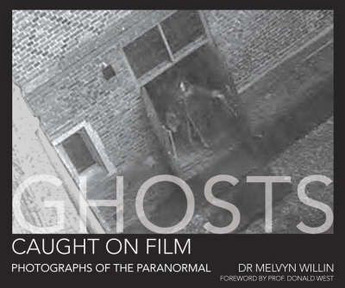|
Review: Ghosts Caught on Film – Photographs of the Paranormal Author: Dr Melvyn Willin Publisher: David & Charles Ltd, Cincinnati, 2007 Hardback, 156 pages, colour illustrations, 21×17.5cm  It’s still much more fun to curl up comfy with a book than to gaze at a computer screen or play with a small handheld device, and this experience is enhanced if the book has a pleasant weight, size and feel to it, as Ghosts Caught on Film does. It just sits nicely. It’s been lurking on the coffee table a couple of months, and I’ve been reading and studying it bit by bit. It seems more suited to that than a cover-to-cover read. The book is well structured, with the mysterious photographs catergorised in chapters, each chapter having an introduction. The chapter titles are: The earliest Images; Photographs of the Invisible; Lookalikes – Beyond Coincidence?; Everyday Anomalies; Most Famous Mysteries. The photos date from the nineteenth century to this century (just), and were mainly shot on film, (as the title suggests) not digital cameras. I haven’t seen the later books in this series (see below) but it would be good to have a companion volume of digital photographs. The first book I stumbled on – by accident, actually, in 2005 – that set me off buying books on the paranormal was Photographs of the Unknown by Richard Kelly (New English Library Ltd, 1980), a medium sized volume packed to the gunwales with every photo of the paranormal you ever saw, including Bigfoot, the Loch Ness Monster and a bunch of UFOs, and some photos you hadn’t seen. The text accompanying each photo is secondary, yet informative and well researched. I would still recommend this book, which you should be able to find in a used book shop or on TradeMe. I would like Ghosts Caught on Film to be as good as Kelly’s book, and it almost is. You would expect, given advances in digital publishing and printing technology, that the photos would be clearer than the 1980 book, which was produced entirely using analogue technology, but they are generally not. Also, because of the format of the book, the photos are sometimes too small. The designer has eschewed full bleed for the photos, preferring to place them (smaller) on textured backgrounds. In some cases this is annoying, as you really want a decent look at the photo in order to make up your own mind about it. Making up your own mind is very much how the text is pitched. Dr Willin provides some useful historical and contextual background on each photograph, as well as an opinion on its likelihood of portraying the paranormal. We are then left to draw our own conclusions. I guess that’s fine, especially in the case of the historical examples, most of which will probably remain as mysteries for eternity. But the main beef I have with this book is the (deliberate?) lameness of the analyses of the photographs. A Baffling presence on Calvary Hill (pgs 80-81), for example, is obviously a case of a person walking through the photograph during the long exposure. (I say this as a person who has taken and seen a lot of similar photographs: the effect is totally recognisable.) The Spirit of Old Nanna (pgs 120-121) is (sorry, but) a camera strap catching the flash. The Haunted Doorway (pgs 146-147) is obviously a hoax photograph. I could go on. But half the fun of this book is in trying to work out what actually has gone on in the photographs, and the author has deliberately avoided debunking the photos for this reason. I imagine the publisher would’ve also had a hand in this. They want to sell the book, after all, and a cut and dried explanation for each and every photo would work against that, for most people anyway. Perhaps some middle ground could be found; that is, somewhat more credible analyses of the photos by named experts, but still leaving room for the interaction of reader opinion. My personal favourite candidate for a photograph that genuinely captures a ghost on film would be the image shown as The Girl who Returned (pgs 134-135). It shows the burning of the Wem Town Hall in Shropshire, England, in 1995. The figure of a girl amid the flames can be clearly seen, and it is thought this is the girl who allegedly burned down the old Town Hall on the same site in 1677. The photo has been published elsewhere, and I have not yet researched it, but if it’s not an outright fake then the situation would seem to have all the right sort of psychological ingredients for a manifestation to appear on film. There are other titles in this series of books: Ghosts Caught on Film 2; GCOF 3; The Paranormal Caught on Film (2008) and Monsters Caught on Film (2010). All up, they would make a valuable collection and provide a useful reference source of paranormal photographs.
0 Comments
|
Ectoplasmic Residueis a blog by James Gilberd - leader and co-founder of Strange Occurrences. Views expressed here do not necessarily represent those of the Strange Occurrences team. AuthorJames Gilberd is an amateur paranormalist, writer and musician, and a professional photographer, living in Wellington, New Zealand. Archives
February 2021
Categories
All
|
 RSS Feed
RSS Feed
